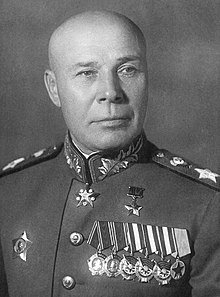
Back Semion Timoshenko AN سيميون تيموشينكو Arabic سيميون تيموشينكو (ضابط من الامبراطوريه الروسيه) ARZ Semyon Timoşenko Azerbaijani Тимошенко Семён Константинович Bashkir Сямён Канстанцінавіч Цімашэнка Byelorussian Семьон Тимошенко Bulgarian Semion Timoixenko Catalan Semjon Konstantinovič Timošenko Czech Тимошенко Семён Константинович CV
Semyon Konstantinovich Timoshenko (Russian: Семен Константинович Тимошенко; Ukrainian: Семен Костянтинович Тимошенко, Semen Kostyantynovych Tymoshenko) (18 February [O.S. 6 February] 1895 – 31 March 1970) was a Soviet military commander, Marshal of the Soviet Union, and one of the most prominent Red Army commanders during the Second World War.
Born to a Ukrainian family in Bessarabia, Timoshenko was drafted into the Imperial Russian Army and saw action in the First World War as a cavalryman. On the outbreak of the Russian Revolution he joined the Red Army. He served with distinction during the Russian Civil War and the subsequent Polish–Soviet War, which brought him into Vladimir Lenin's and Joseph Stalin's favour. Rapidly rising through the ranks, Timoshenko held several regional commands throughout the 1930s and survived the Great Purge. He led the Ukrainian Front during the Soviet invasion of Poland in 1939. In early 1940, Timoshenko took over the command of the Winter War in Finland from Kliment Voroshilov and turned the tides for the Soviets, forcing the Finnish to sue for peace a few months later. In May 1940, he was named a Marshal of the Soviet Union and the People's Commissars for Defence. In the latter capacity, he took steps to modernise the Red Army and prepare for a likely war with Nazi Germany.
On the outbreak of the German invasion of the Soviet Union, Timoshenko was named chairman of the Stavka. Stalin replaced him as Stavka chairman a month later; he went on to hold a series of important commands in the following year. In late 1941, he organised a major counter-offensive in Rostov, which brought him international renown. His fortunes had faltered by mid-1942, in particular after the overwhelming Soviet defeat at the Second Battle of Kharkov, and he was relieved from the command of the newly formed Stalingrad Front. He was recalled later that year and appointed commander of the Northwestern Front, and as a Stavka representative he oversaw and coordinated the activities of several fronts in various times during the last phase of the war, including the Leningrad and Volkov fronts, the North Caucasus Front and the Black Sea Fleet, and the 2nd and 3rd Ukrainian fronts.
After the war, Timoshenko held commands in several Soviet military districts until his effective retirement in 1960. He died in 1970 at the age of 75.
© MMXXIII Rich X Search. We shall prevail. All rights reserved. Rich X Search
